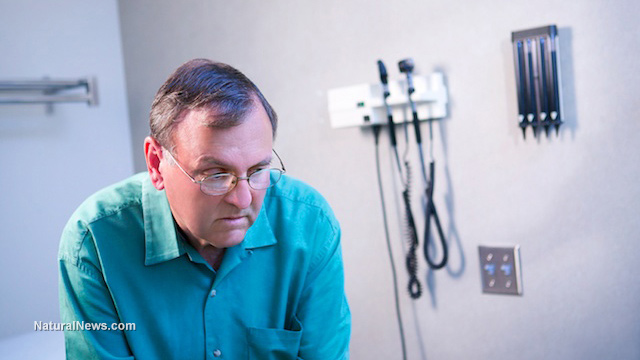Super gonorrhea: treating it may actually speed up the spread of the disease
Wednesday, June 15, 2016 by: L.J. Devon, Staff Writer
Tags: super gonorrhea, antibiotic resistance, superbugs

(NaturalNews) Hospitals and medical clinics are having a difficult time containing the sexually transmitted disease gonorrhea, a bacterial infection which causes painful urination and discharge from the genitals, among other distressing symptoms.
The CDC now admits: "Gonorrhea has progressively developed resistance to the antibiotic drugs prescribed to treat it." Antibiotic resistance has become so troublesome that patients are now being diagnosed with a form of "super gonorrhea" which doesn't respond to current medical treatments. Penicillin, tetracycline, fluoroquinolones and cefixime were once used to treat the bacterial infection, but are all failing, causing the bacteria to evolve into more pervasive forms.
Antibiotics (not necessarily sexual activity) spreading gonorrhea and making it worse
While increased sexual activity with multiple partners heightens one's risk of contracting the disease, patients aren't being told that gonorrhea is spreading even faster and becoming more pervasive because of antibiotic treatments.Think about that for a moment: It's modern medicine that's making gonorrhea infections worse, causing the disease to spread.
Swiss researchers Stephanie Fingerhuth and Christian Althaus of ETH Zurich, created a mathematical model to study the spread of Neisseria gonorrhoeae and learn the nature of its growing bacterial resistance. Their study shows that increased screening and treatment actually do more harm than good, emboldening bacterial resistance that makes the disease more pervasive.
The research was the first of its kind to assess antibiotic resistance for super gonorrhea in a quantitative manner. Pooling data from two international surveillance programs, the researchers were able to pinpoint the speed at which resistant gonorrhea spreads in different populations. Analyzing sexual behavior of homosexual and heterosexual men, the researchers put together a model detailing incidence of gonorrhea, including the number of new cases each year and the overall number of cases. After putting it all together, their mathematical model could then predict the spread of gonorrhea.
The first trend they found was in heterosexual men. The spread of gonorrhea doubles in this population group every 16 months. In homosexual men, the observed spread was much faster, doubling every 6 months on average, largely because they had more partners than heterosexual men.
Still, it wasn't just the higher number of sexual partners that caused gonorrhea to spread faster. Upon further investigation, the researchers found that men who have sex with men were spreading gonorrhea faster because they were more frequently getting antibiotic treatment for the disease – antibiotic treatment that was making the bacteria more resistant.
Homosexual men sought screening and treatment more frequently, and it was the treatment causing the bacterial resistance over time.
The authors of the study wrote: "Estimating rates of resistance spread is useful for projecting future resistance levels and the expected time it will take until a certain threshold in the proportion of antibiotic-resistant N. gonorrhoeae is reached."
They warn: "Future treatment recommendations for N. gonorrhoeae should carefully balance prevention of N. gonorrhoeae infection and avoidance of the spread of resistance."
Current medical treatment for destroying bacteria (antibiotics) is failing, as humanity faces evolving pathogens. The bacteria we try to destroy are resisting treatment with increasing infectious power. Attempts to control pathogens by destroying microbiology altogether only spur nature to hit back harder with increased resistance. Future treatments for bacterial infections must work with the patient's individual microbiome, not against it. The focus must be centered on strengthening the individual's immune system, instead of destroying its mutually beneficial microbial hosts with antibiotics.
Sources include:
Journal.PLOS.org
CDC.gov
Science.NaturalNews.com
Fingerhuth, S.M., Bonhoeffer, S., Low, N. & Althaus, C.L. (2016) Antibiotic-resistant Neisseria gonorrhoeae Spread Faster with More Treatment, Not More Sexual Partners. PLOS Pathogens, May 19, 2016
Super gonorrhea at FETCH.news
Get independent news alerts on natural cures, food lab tests, cannabis medicine, science, robotics, drones, privacy and more.
Take Action: Support Natural News by linking to this article from your website
Permalink to this article:
Embed article link: (copy HTML code below):
Reprinting this article:
Non-commercial use OK, cite NaturalNews.com with clickable link.
Follow Natural News on Facebook, Twitter, Google Plus, and Pinterest
- Newly released JFK files reveal Pentagon's role in creating Lyme disease and covid in the same lab
- Ginseng's hidden anti-aging power: How compound K is rewriting the rules of skincare
- L.A.'s rebuilding nightmare: Only 4 permits issued after fire destroys 6,000 homes
- Dr. Suzanne Humphries makes bombshell appearance on Joe Rogan podcast, exposing vaccine industry deception back to POLIOMYELITIS
- Former Congresswoman exposes CCP's deep infiltration of California through universities, ports, and fentanyl
- PROCESSED TABLE SALT in foods found to fuel depression
- Here are TEN all-natural ways to protect your garden without using harmful chemicals
- “Independent” anti-Russia outlet MEDUZA faces COLLAPSE as US funding dries up
- Discovery of vast underground city beneath Giza pyramids challenges human history
- The hidden battle in your glass: How A1 and A2 milk could shape your health
- BPA: The hidden hormone disruptor sabotaging your health - and how to fight back
- Black cumin seed oil emerges as a powerful ally against breast cancer and chronic inflammation
- Catastrophic 7.7 earthquake devastates Myanmar and Thailand; death toll could reach 100,000
- CDC finally halts $11 billion COVID funding scam as health officials admit the ‘pandemic’ was a fraud
- Nomi Prins reveals how central bankers reshaped the global economy in “Collusion”
- “Endgame: The Hidden Agenda 21” unveils a world of conspiracy and control
- Chaos in Amsterdam: Five injured in broad daylight knife attack near Dam Square
- Putin vows to 'finish off' Ukraine, accuses West of prolonging the war
- Newly released JFK files reveal Pentagon's role in creating Lyme disease and covid in the same lab
- Analysis: The coming economic collapse, a mass uprising and Trump's three secret weapons to halt the growing revolt
- Festive flavors: The sweet history, nutritional profile and health benefits of pecan pie
- Elon Musk: Aliens could be here on Earth RIGHT NOW
- Trump reverses course on Gaza plan, says “nobody is expelling Palestinians”
- Big Pharma's $8 Billion bribery scheme exposed: how doctors are pushed to prescribe junk science, not heal
- Boys are back in town: Trump’s patriotic alpha crew takes the wheel while toxic females ride in the backseat
- Reclaim your health: How midlife exercise reverses years of inactivity
- A lack of integrity in Academia: Harvard professor found GUILTY of fraudulent research to promote CRT theory
- Survival 101: Effective EMF blocking techniques
- EPA advisor admits the agency is funneling billions to climate groups ahead of Trump’s return to White House
- Dr. Mike Yeadon releases 15-minute testimony - WATCH - about genocidal intent of COVID “vaccines”
- 5 Simple steps to boost your brainpower: How to strengthen executive function in a distracted world
- Florida takes a stand: DeSantis proposes permanent ban on mRNA vaccine mandates
- Sugarcane extract superior to cholesterol-lowering drugs?
- Mike Adams Sermon 66: God will DESTROY ISRAEL for its wickedness
- Pilots report mysterious lights 'moving at extreme speeds' across Oregon skies
- Space war brewing? Russia threatens to destroy Starlink satellites
- EPA advisor admits the agency is funneling billions to climate groups ahead of Trump’s return to White House
- California's social media censorship law struck down: A victory for free speech or a threat to online safety?
- The Health Ranger releases “Vaccine Zombie” song and music video, using AI-animated zombies for the music video
- Dr. Mike Yeadon releases 15-minute testimony - WATCH - about genocidal intent of COVID “vaccines”
- The pandemic as a tool for INDOCTRINATION: Understanding “The Indoctrinated Brain” by Dr. Michael Nehls
- Newly released JFK files reveal Pentagon's role in creating Lyme disease and covid in the same lab
- Florida takes a stand: DeSantis proposes permanent ban on mRNA vaccine mandates
- Mike Adams releases country western hit single: Goin’ Back in Time is Comin’ Home
- Mike Adams releases music poetry sensation: A Child of God
- “Why we influenced the 2020 elections”: Facebook files reveal the coordinated effort to bury the Hunter Biden laptop story
- Unpacking the Lies That We’ve Been Fed – new song and music video released by Mike Adams, the Health Ranger
- RFK Jr. clears key hurdle: Sen. Susan Collins backs controversial HHS nominee, signaling a new era for health policy
- Mike Adams releases new song and music video: Nothing More Disgusting Than a Globalist
- Michigan sheriff announces criminal investigation into 2020 election crimes, Dominion Voting Systems
- Israeli soldiers accused of even more torture and abuse in the West Bank
- Migrants are taking advantage of recent hurricanes to scam residents and loot their homes
- House Intelligence Committee calls for the ARREST and PROSECUTION of Dr. Anthony Fauci
- Rep. Nancy Mace introduces bill to ban biological males from female facilities on federal property
- Red Cross issues warning to stop blood plasma donations from vaccinated people
- Scientists confirm: GENIUS brain function can be spontaneously unleashed in humans without any apparent cause
- EPA advisor admits the agency is funneling billions to climate groups ahead of Trump’s return to White House
- HYSSOP: What research reveals about the health benefits of this ancient holy herb
- Two containers with completed ballots fall out of truck in Florida
- Fully vaccinated about to see “tsunami” of illness and death, warns virologist
- Global leaders unite to clamp down on “misinformation” with UN-backed Cascais Declaration
- BREAKING: 2025 NDAA authorizes mandatory military draft of WOMEN across America… as Pentagon pursues global NUCLEAR war with both Russia and China at the same time
- Michael Yon warns of a ZIONIST TAKEOVER in Trump’s second administration
- BOMBSHELL: DNA testing kits are a SCAM to develop ethnic-specific bioweapons
- Ozempic and Wegovy weight loss drugs are injectable LIZARD VENOM PEPTIDES that may unleash a devastating wave of organ failure… side effects align with symptoms of SNAKE BITES
- Israeli soldiers accused of even more torture and abuse in the West Bank
- These 13 countries just signed an agreement to engineer a global FAMINE by destroying food supply
- NASA admits that climate change occurs because of changes in Earth’s solar orbit, and NOT because of SUVs and fossil fuels
- RFK Jr. clears key hurdle: Sen. Susan Collins backs controversial HHS nominee, signaling a new era for health policy
- Sermon 30: How Jesus reveals Caesar’s FAKE CURRENCY and FALSE AUTHORITY
- Coriander seeds: Ancient medicine backed by modern science
- Arizona officials claim Maricopa County needs 10-13 days to tabulate results of the election
Science News & Studies
Medicine News and Information
Food News & Studies
Health News & Studies
Herbs News & Information
Pollution News & Studies
Cancer News & Studies
Climate News & Studies
Survival News & Information
Gear News & Information
News covering technology, stocks, hackers, and more



"Big Tech and mainstream media are constantly trying to silence the independent voices that dare to bring you the truth about toxic food ingredients, dangerous medications and the failed, fraudulent science of the profit-driven medical establishment.
Email is one of the best ways to make sure you stay informed, without the censorship of the tech giants (Google, Apple, Facebook, Twitter, YouTube, etc.). Stay informed and you'll even likely learn information that may help save your own life."
–The Health Ranger, Mike Adams












































